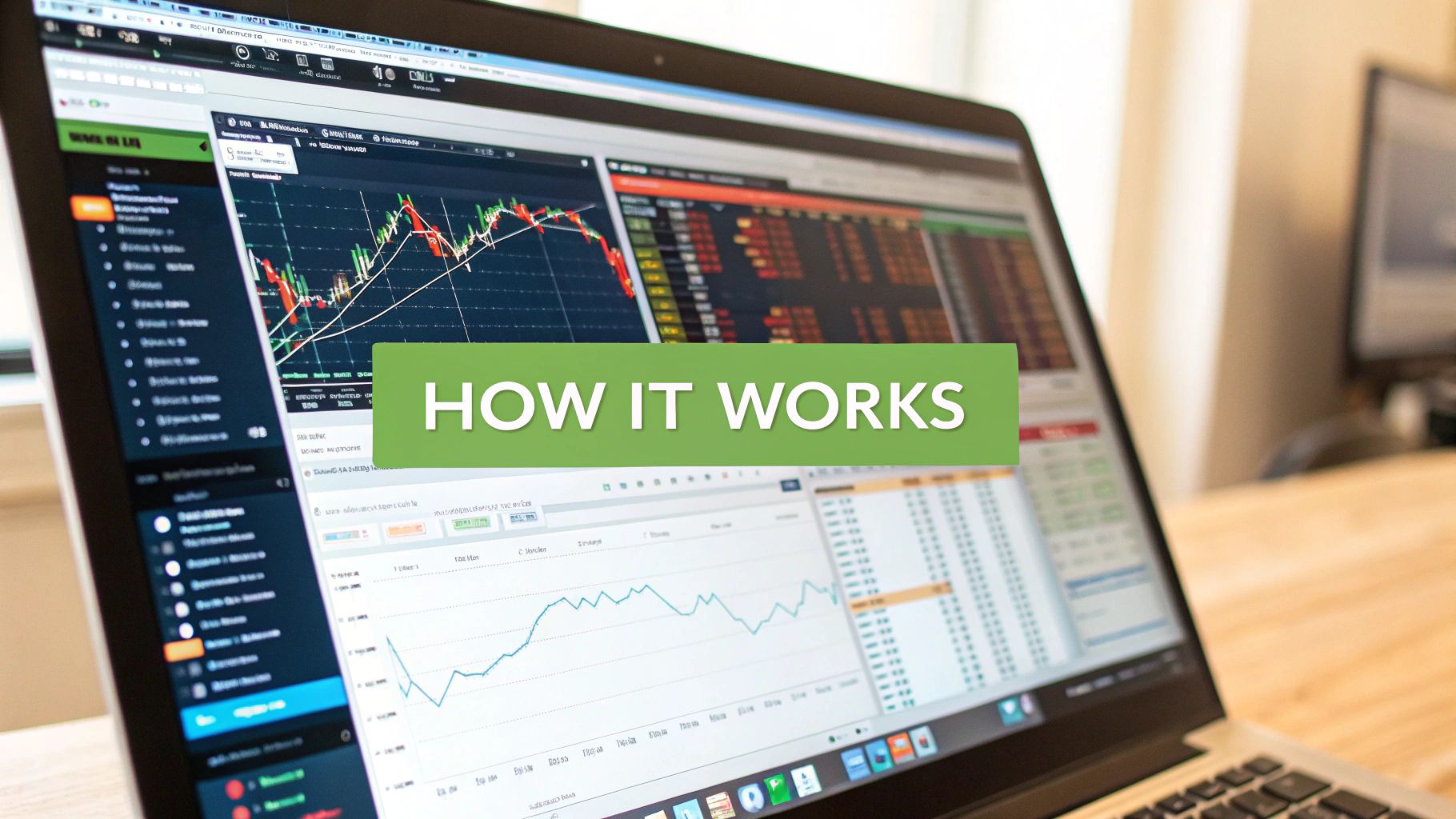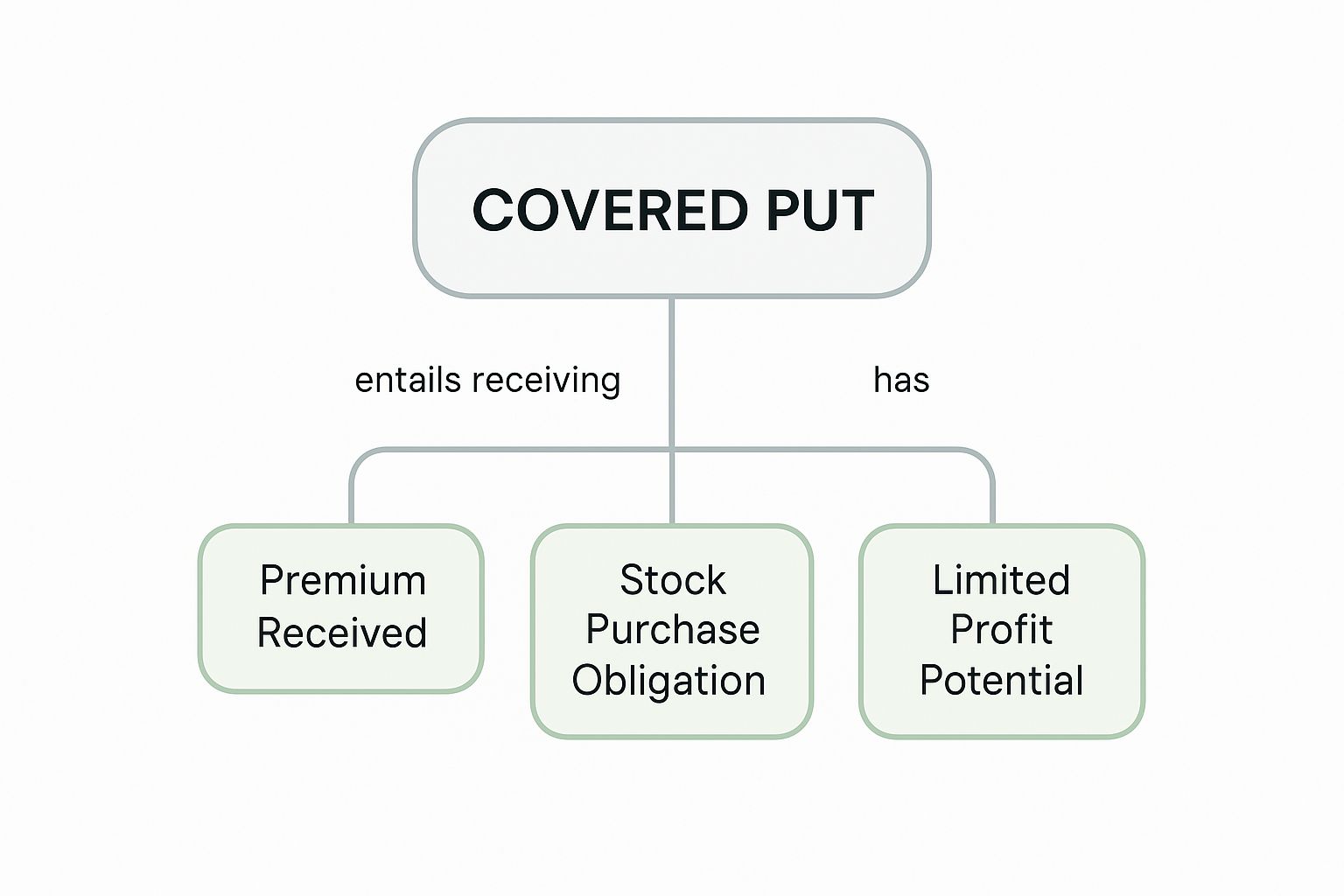What Is a Covered Put and How Does It Work
If a stock moves past your strike, the option can be assigned — meaning you'll have to sell (in a call) or buy (in a put). Knowing the assignment probability ahead of time is key to managing risk.
Posted by
Related reading
Mastering Option Extrinsic Value
Unlock the core of options trading by mastering option extrinsic value. Learn how time, volatility, and strategy impact your profits with this guide.
A Trader's Guide to Short Put Options
Discover how to use short put options to generate consistent income or buy stocks at a lower price. This guide covers key strategies and risk management.
8 Best Stocks for Put Selling in 2025
Discover the best stocks for put selling to generate consistent income. Our guide breaks down top picks, key metrics, and actionable strategies for success.
A covered put is a go-to strategy for traders who are either bearish or neutral on a stock. In a nutshell, you short-sell 100 shares of a stock while simultaneously selling a put option against that same stock. This move lets you pocket the option premium upfront while betting that the stock's price will either drop or tread water.
Decoding the Covered Put Strategy

The "covered" part can throw people off, but it's the heart of the strategy. Think of it this way: when you sell a put, you take on an obligation to buy 100 shares at a specific price (the strike price) if the option holder decides to exercise it.
Your short stock position is your insurance policy—it covers that obligation. If you get assigned and are forced to buy the shares, you just use them to close out your short position. No scrambling, no panic. It’s a clean exit.
This setup helps a bearish trader in two key ways:
- Generate Immediate Income: You collect cash from the premium as soon as you sell the put option.
- Lower Your Cost Basis: That premium you collected effectively lowers the price where your short position starts making money.
The covered put is a financial options strategy that really shines in markets that are heading down or going nowhere. It gained traction as options trading became more standardized in the late 1990s and early 2000s, thanks to exchanges like the Chicago Board Options Exchange (CBOE). To see exactly how this plays out, check out our complete guide on what is a covered put option.
To make this crystal clear, here’s a quick breakdown of what you're doing and why.
Covered Put Strategy at a Glance
| Component | What You Do | Your Goal |
|---|---|---|
| Stock Position | Short-sell 100 shares of a stock. | To profit from a decline in the stock's price. |
| Option Position | Sell one put option on the same stock. | To collect premium income upfront. |
| Coverage | The short shares "cover" your obligation to buy. | To create a defined-risk exit if the put is assigned. |
This table shows how the two pieces of the trade work together to create one cohesive strategy.
The core idea is simple: you’re getting paid for your willingness to close your short position at a price you already agreed on.
If the stock drops like you predicted, you win twice—you profit from your short sale and you keep the premium you collected.
Just remember, this strategy is built for a specific market view. It's for when you expect a stock to either fall modestly or just drift sideways. It’s not the right tool if you're predicting a massive crash, because your profit on the short sale gets capped if that put option gets exercised. You can find more on the background of this strategy over at IG.com.
Seeing the Covered Put in Action
Theory is one thing, but seeing how a trade plays out in the real world makes it all click. Let’s walk through a covered put from start to finish to see how the numbers work.
Imagine you're bearish on a company we'll call Innovate Corp. (ticker: INVT), which is currently trading at $100 per share. You think it's headed down, so you decide to set up a covered put.

Here’s how you’d open the position:
- Short 100 Shares of INVT: First, you borrow and sell 100 shares at the market price of $100. This immediately puts $10,000 in your account (before commissions).
- Sell a Put Option: At the same time, you sell one INVT put contract with a $95 strike price that expires in 30 days. For taking on this obligation, you get paid a premium of $2.50 per share, for a total of $250.
The trade is now live. You have a short stock position "covered" by the put you sold, and you’ve already pocketed $250 in cash. Now, let's fast forward 30 days and see what could happen.
Scenario 1: The Stock Drops Below the Strike
This is exactly what you hoped for. Let's say INVT tanks and is trading at $90 per share when the option expires.
Because the stock price ($90) is below your $95 strike price, the put option is "in-the-money." The person who bought it will definitely exercise their right to sell you shares at $95. You're now obligated to buy 100 shares at that price.
- No problem. You use those shares you just bought at $95 to close out your initial short position.
- You originally shorted the stock at $100 and effectively bought it back at $95. That's a $5 per share profit, or $500 total.
- Plus, you keep the $250 premium you collected upfront.
Total Profit: Your gain from the stock ($500) plus the option premium ($250) adds up to a $750 profit. This is your maximum possible gain on this specific trade.
Scenario 2: The Stock Stays Above the Strike
What if INVT only dips a little, or even stays flat? Let's say it closes at $98 per share on expiration day.
Since the stock price ($98) is higher than your $95 strike, the put option expires worthless. Why would anyone sell you their shares for $95 when they could get $98 on the open market? They wouldn't.
- The option simply vanishes, and you keep the entire $250 premium free and clear.
- But you still have your short stock position. You shorted at $100, and with the stock now at $98, you have an unrealized profit of $2 per share ($200).
From here, you could close the short position to lock in that $200 gain or sell another put for the next month to keep generating income from the position.
Scenario 3: The Stock Rises
This is the scenario where things go wrong. Imagine INVT rallies and is trading at $110 per share at expiration.
Just like in the last scenario, the $95 put option expires worthless. You keep the $250 premium. The problem, however, is your short stock position.
- You shorted the stock at $100, but now it's trading at $110. To close your position, you'd have to buy back the shares at a higher price, creating a loss of $10 per share ($1,000 total).
- The $250 premium you collected helps, but it only cushions a small part of that loss.
Your net unrealized loss would be $750 (the $1,000 stock loss minus the $250 premium gain). This highlights the real danger of any short-selling strategy: because a stock can theoretically rise forever, your risk is unlimited.
Calculating Your Potential Profit and Loss
Alright, let's get into the numbers. Understanding the math behind a covered put is non-negotiable if you want to manage your risk and know what to expect. The good news? The formulas are pretty simple. They just tie together the two pieces of the trade: your short stock and the put you sold.
Let’s break down exactly how to calculate your best-case, worst-case, and breakeven scenarios.
Calculating Maximum Profit
With a covered put, your potential profit is capped. This happens if the stock price tanks, dropping to or below the strike price of the put you sold. At that point, the option gets assigned, and you're forced to buy back the shares.
Here’s the simple formula for that best-case scenario:
Maximum Profit = (Short Sale Price - Strike Price) + Premium Received
Let's stick with our INVT example. You shorted the stock at $100 and sold the $95 strike put for a $2.50 premium. Your maximum profit would be ($100 - $95) + $2.50 = $7.50 per share, or $750 for the whole position.
This is a great way to visualize how all the pieces of a covered put fit together.

As you can see, the premium you collect directly pads your potential profit, even though you have that obligation to buy the stock back if things go your way.
Finding Your Breakeven Point
Your breakeven is the exact stock price where you don't make a dime, but you don't lose one either. For a covered put, you find this by adding the premium you collected to the price where you shorted the stock. This specific risk-reward profile is why the strategy is popular with traders who are only mildly bearish. You can dig deeper into this calculation with this detailed guide from MooMoo.
- Breakeven Formula: Short Sale Price + Premium Received
- Our Example: $100 + $2.50 = $102.50
If INVT creeps up to $102.50 by the time the option expires, the $2.50 in premium you pocketed will perfectly cancel out the $2.50 per share you lost on your short stock position.
Understanding Your Maximum Loss
Now for the most important part: the risk. With a covered put, your potential loss is theoretically unlimited. Why? Because you're short 100 shares of the stock. If the price keeps climbing, your losses keep growing.
That premium you collected acts as a small buffer, but it does not put a ceiling on your risk. If the stock unexpectedly skyrockets, the financial damage could be huge. This is what makes solid risk management absolutely essential when running this strategy.
When You Should Use a Covered Put

Knowing the mechanics is one thing, but deploying a covered put at the right moment is what separates theory from profit. This isn't a strategy for every market. It really shines when your outlook on a stock is mildly bearish or neutral.
If you expect a stock to drift slowly lower or just bounce around in a tight range, the covered put becomes a powerful tool. It lets you generate immediate cash from the option premium while you wait for your bearish view to come to fruition. Think of it as a proactive move, not just a passive short sale.
Ideal Scenarios for a Covered Put
The best times to pull out the covered put playbook line up with a few specific goals. You’ll want to consider it when you want to:
- Earn income from a stagnant stock: If a stock you’re shorting is going nowhere fast, selling a put lets you collect cash instead of just waiting around.
- Hedge a short position: That premium you collect acts as a small cushion, slightly lowering your risk if the stock unexpectedly moves up against you.
- Target a specific exit price: Selling a put with a strike price where you’d be happy to close your short creates a clear, predefined exit plan.
A covered put transforms a simple bearish bet into an income-generating machine. You’re essentially getting paid to set a target price for closing your short position.
Historically, covered puts have been less common than their cousin, the covered call, simply because markets tend to trend up over time. But during bear markets or periods of high volatility, their usage spikes. Data from major options exchanges consistently shows traders flocking to bearish strategies like this when uncertainty cranks up.
Ultimately, this strategy is for the patient bear. It’s for the trader who sees a slow decline on the horizon and wants to monetize that expectation. If you're ready to get started, our guide on how to sell covered puts can walk you through the process step-by-step.
Weighing the Benefits and Risks
Like any options strategy, the covered put has its own unique give-and-take. It's a solid way to generate income from a bearish outlook, but it's not without some serious risks you need to respect before you even think about placing a trade.
The big draw is the immediate income. The second you sell that put option, the premium hits your account. It's an instant cash return. This premium also chips away at the cost basis of your short stock position, giving you a small but helpful cushion if the stock ticks up against you. For a full breakdown, check out our guide where we detail how covered puts are explained from top to bottom.
But the other side of that coin—the risk—demands your full attention.
The Tradeoff Between Profit and Loss
The single most significant risk here is the unlimited loss potential. Because you’re holding a short stock position to "cover" the put, your losses could theoretically be infinite if the stock suddenly takes off like a rocket. The premium you collected will feel pretty small if the stock doubles.
The core dilemma of a covered put is its lopsided risk profile: your maximum gain is strictly capped, but your maximum loss is not.
Getting your head around this is non-negotiable. You are intentionally accepting uncapped risk in exchange for a limited, known reward. This is why the covered put is really built for mildly bearish or neutral outlooks where you just don't see a massive rally on the horizon.
To make it crystal clear, let's stack up the pros and cons of the covered put.
Benefits vs Risks of a Covered Put
The table below gives you a side-by-side look at what you gain versus what you stand to lose.
| Benefits | Risks |
|---|---|
| Instant Income: Collect premium the moment you sell the put. | Unlimited Loss Potential: A short stock has no ceiling on its price. |
| Cost Basis Reduction: The premium lowers your short position's entry price. | Capped Profit: Your gain is limited to the premium collected. |
| Assignment Benefit: If assigned, you buy back shares at a known price. | Missed Opportunity: You miss out if the stock plummets far below your strike. |
Ultimately, it comes down to a simple trade-off. You're giving up the chance for a huge win if the stock tanks in exchange for immediate income and a slightly better cost basis on your short position. But you're also taking on the massive risk of a runaway bull market. Knowing if that trade-off works for you is the key to using this strategy effectively.
Your Top Covered Put Questions, Answered
Once you start digging into the covered put strategy, a few practical questions always pop up. Getting these sorted out is crucial for trading with confidence and dodging those rookie mistakes. Let's walk through the most common questions traders have when they first explore this strategy.
How Is a Covered Put Different from a Naked Put?
The real difference boils down to one thing: the short stock position. A covered put is "covered" because you've already shorted 100 shares of the stock. If the put gets assigned, you just use the shares you're forced to buy to close out your existing short position. Simple.
A naked put, on the other hand, is sold without that safety net. If you get assigned on a naked put, you have to find the cash to buy 100 shares on the open market, instantly creating a new long stock position. It's a much riskier game with a much higher capital requirement.
What Happens If I Get Assigned Early?
Early assignment is always a possibility with American-style options, so it's good to be prepared. If your covered put is assigned before it expires, you are simply forced to buy 100 shares at the strike price. That action automatically closes out your short stock position, and the trade is done.
The moment you're assigned, your profit or loss is locked in. It's the difference between your initial short sale price and the strike price where you bought back, plus the premium you collected. At that point, you can no longer profit if the stock continues to fall.
Can I Use a Covered Put on Any Stock?
Technically, yes—as long as the stock has an active options market and your broker lets you short it. But that doesn't mean you should. This strategy really shines when you're mildly bearish on a stock and expect it to drift down slowly or trade flat.
The best candidates are stocks with plenty of options liquidity, which helps you get fair prices and execute trades smoothly. And while stocks with higher implied volatility will offer fatter premiums, remember what that means: the market is expecting big price swings, which cranks up your risk.
Ready to stop guessing and start making data-driven options trades? Strike Price provides real-time probability metrics for every strike, helping you balance safety and premium income. Our smart alerts and tracking dashboard turn complex decisions into simple, informed actions. Start your free trial today at strikeprice.app and see what your portfolio can really do.